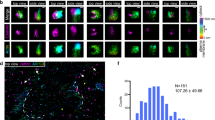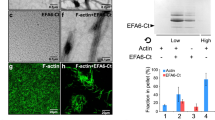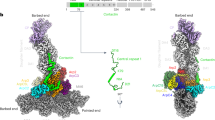Abstract
Cortactin is an actin-binding protein that has recently been implicated in endocytosis. It binds directly to dynamin-2 (Dyn2), a large GTPase that mediates the formation of vesicles from the plasma membrane and the Golgi. Here we show that cortactin associates with the Golgi to regulate the actin- and Dyn2-dependent transport of cargo. Cortactin antibodies stain the Golgi apparatus, labelling peripheral buds and vesicles that are associated with the cisternae. Notably, in vitro or intact-cell experiments show that activation of Arf1 mediates the recruitment of actin, cortactin and Dyn2 to Golgi membranes. Furthermore, selective disruption of the cortactin–Dyn2 interaction significantly reduces the levels of Dyn2 at the Golgi and blocks the transit of nascent proteins from the trans-Golgi network, resulting in swollen and distended cisternae. These findings support the idea of an Arf1-activated recruitment of an actin, cortactin and Dyn2 complex that is essential for Golgi function.
This is a preview of subscription content, access via your institution
Access options
Subscribe to this journal
Receive 12 print issues and online access
$209.00 per year
only $17.42 per issue
Buy this article
- Purchase on Springer Link
- Instant access to full article PDF
Prices may be subject to local taxes which are calculated during checkout







Similar content being viewed by others
References
Stamnes, M. Regulating the actin cytoskeleton during vesicular transport. Curr. Opin. Cell Biol. 14, 428–433 (2002).
Lippincott-Schwartz, J. Cytoskeletal proteins and Golgi dynamics. Curr. Opin. Cell Biol. 10, 52–59 (1998).
De Matteis, M. A. & Morrow, J. S. The role of ankyrin and spectrin in membrane transport and domain formation. Curr. Opin. Cell Biol. 10, 542–549 (1998).
Fucini, R. V., Chen, J. L., Sharma, C., Kessels, M. M. & Stamnes, M. Golgi vesicle proteins are linked to the assembly of an actin complex defined by mAbp1. Mol. Biol. Cell 13, 621–631 (2002).
Musch, A., Cohen, D., Kreitzer, G. & Rodriguez-Boulan, E. cdc42 regulates the exit of apical and basolateral proteins from the trans-Golgi network. EMBO J. 20, 2171–2179 (2001).
Luna, A. et al. Regulation of protein transport from the Golgi complex to the endoplasmic reticulum by CDC42 and N-WASP. Mol. Biol. Cell 13, 866–879 (2002).
Fucini, R. V. et al. Activated ADP-ribosylation factor assembles distinct pools of actin on golgi membranes. J. Biol. Chem. 275, 18824–18829 (2000).
Allan, V. J., Thompson, H. M. & McNiven, M. A. Motoring around the Golgi. Nature Cell Biol. 4, E236–E242 (2002).
di Campli, A. et al. Morphological changes in the Golgi complex correlate with actin cytoskeleton rearrangements. Cell Motil. Cytoskeleton 43, 334–348 (1999).
Valderrama, F. et al. Actin microfilaments are essential for the cytological positioning and morphology of the Golgi complex. Eur. J. Cell Biol. 76, 9–17 (1998).
Cao, H. et al. Cortactin is a component of clathrin-coated pits and participates in receptor-mediated endocytosis. Mol. Cell Biol. 23, 2162–2170 (2003).
McNiven, M. A. et al. Regulated interactions between dynamin and the actin-binding protein cortactin modulate cell shape. J. Cell Biol. 151, 187–198 (2000).
Sweitzer, S. M. & Hinshaw, J. E. Dynamin undergoes a GTP-dependent conformational change causing vesiculation. Cell 93, 1021–1029 (1998).
Hinshaw, J. E. & Schmid, S. L. Dynamin self-assembles into rings suggesting a mechanism for coated vesicle budding. Nature 374, 190–192 (1995).
McNiven, M. A. Dynamin: a molecular motor with pinchase action. Cell 94, 151–154 (1998).
Hinshaw, J. E. Dynamin and its role in membrane fission. Annu. Rev. Cell Dev. Biol. 16, 483–519 (2000).
McNiven, M. A., Cao, H., Pitts, K. R. & Yoon, Y. The dynamin family of mechanoenzymes: pinching in new places. Trends Biochem. Sci. 25, 115–120 (2000).
Orth, J. D. & McNiven, M. A. Dynamin at the actin-membrane interface. Curr. Opin. Cell Biol. 15, 31–39 (2003).
Qualmann, B., Kessels, M. M. & Kelly, R. B. Molecular links between endocytosis and the actin cytoskeleton. J. Cell Biol. 150, F111–F116 (2000).
Schafer, D. A. Coupling actin dynamics and membrane dynamics during endocytosis. Curr. Opin. Cell Biol. 14, 76–81 (2002).
Krueger, E. W., Orth, J. D., Cao, H. & McNiven, M. A. A dynamin-cortactin-Arp2/3 complex mediates actin reorganization in growth factor-stimulated cells. Mol. Biol. Cell 14, 1085–1096 (2003).
Orth, J. D., Krueger, E. W., Cao, H. & McNiven, M. A. The large GTPase dynamin regulates actin comet formation and movement in living cells. Proc. Natl Acad. Sci. USA 99, 167–172 (2002).
Leelavathi, D. E., Estes, L. W., Feingold, D. S. & Lombardi, B. Isolation of a Golgi-rich fraction from rat liver. Biochim. Biophys. Acta 211, 124–138 (1970).
Weed, S. A., Du, Y. & Parsons, J. T. Translocation of cortactin to the cell periphery is mediated by the small GTPase Rac1. J. Cell Sci. 111, 2433–2443 (1998).
Schwaninger, R., Plutner, H., Davidson, H. W., Pind, S. & Balch, W. E. Transport of protein between endoplasmic reticulum and Golgi compartments in semiintact cells. Methods Enzymol. 219, 110–124 (1992).
Brown, W. J., Goodhouse, J. & Farquhar, M. G. Mannose-6-phosphate receptors for lysosomal enzymes cycle between the Golgi complex and endosomes. J. Cell Biol. 103, 1235–1247 (1986).
Matovcik, L. M., Goodhouse, J. & Farquhar, M. G. The recycling itinerary of the 46 kDa mannose 6-phosphate receptor — Golgi to late endosomes — coincides with that of the 215 kDa M6PR. Eur. J. Cell Biol. 53, 203–211 (1990).
Benmerah, A., Bayrou, M., Cerf-Bensussan, N. & Dautry-Varsat, A. Inhibition of clathrin-coated pit assembly by an Eps15 mutant. J. Cell Sci. 112, 1303–1311 (1999).
Jones, S. M., Howell, K. E., Henley, J. R., Cao, H. & McNiven, M. A. Role of dynamin in the formation of transport vesicles from the trans-Golgi network. Science 279, 573–577 (1998).
De Matteis, M. A. & Morrow, J. S. Spectrin tethers and mesh in the biosynthetic pathway. J. Cell Sci. 113, 2331–2343 (2000).
Erickson, J. W., Zhang, C., Kahn, R. A., Evans, T. & Cerione, R. A. Mammalian Cdc42 is a brefeldin A-sensitive component of the Golgi apparatus. J. Biol. Chem. 271, 26850–26854 (1996).
Cao, H., Thompson, H. M., Krueger, E. W. & McNiven, M. A. Disruption of Golgi structure and function in mammalian cells expressing a mutant dynamin. J. Cell Sci. 113, 1993–2002 (2000).
Maier, O., Knoblich, M. & Westermann, P. Dynamin II binds to the trans-Golgi network. Biochem. Biophys. Res. Commun. 223, 229–233 (1996).
Weaver, A. M. et al. Cortactin promotes and stabilizes Arp2/3-induced actin filament network formation. Curr. Biol. 11, 370–374 (2001).
Weaver, A. M. et al. Interaction of cortactin and N-WASp with Arp2/3 complex. Curr. Biol. 12, 1270–1278 (2002).
Henley, J. R., Krueger, E. W., Oswald, B. J. & McNiven, M. A. Dynamin-mediated internalization of caveolae. J. Cell Biol. 141, 85–99 (1998).
Henley, J. R. & McNiven, M. A. Association of a dynamin-like protein with the Golgi apparatus in mammalian cells. J. Cell Biol. 133, 761–775 (1996).
Cao, H., Garcia, F. & McNiven, M. A. Differential distribution of dynamin isoforms in mammalian cells. Mol. Biol. Cell 9, 2595–2609 (1998).
Anderson, K. L. & McNiven, M. A. Vesicle dynamics during regulated secretion in a novel pancreatic acinar cell in vitro model. Eur. J. Cell Biol. 66, 25–38 (1995).
Toomre, D., Keller, P., White, J., Olivo, J. C. & Simons, K. Dual-color visualization of trans-Golgi network to plasma membrane traffic along microtubules in living cells. J. Cell Sci. 112, 21–33 (1999).
Davidson, H. W. & Balch, W. E. Differential inhibition of multiple vesicular transport steps between the endoplasmic reticulum and trans-Golgi network. J. Biol. Chem. 268, 4216–4226 (1993).
Nishimura, N., Plutner, H., Hahn, K. & Balch, W. E. The delta subunit of AP-3 is required for efficient transport of VSV-G from the trans-Golgi network to the cell surface. Proc. Natl Acad. Sci. USA 99, 6755–6760 (2002).
Acknowledgements
This work was supported by a grant from the National Institutes of Health (DK56647) to M.A.M.
Author information
Authors and Affiliations
Corresponding author
Ethics declarations
Competing interests
The authors declare no competing financial interests.
Supplementary information
Supplementary Information
Supplementary figures S1, S2, S3 and S4 (PDF 592 kb)
Rights and permissions
About this article
Cite this article
Cao, H., Weller, S., Orth, J. et al. Actin and Arf1-dependent recruitment of a cortactin–dynamin complex to the Golgi regulates post-Golgi transport. Nat Cell Biol 7, 483–492 (2005). https://doi.org/10.1038/ncb1246
Received:
Accepted:
Published:
Issue Date:
DOI: https://doi.org/10.1038/ncb1246
This article is cited by
-
A review of Dynamin 2 involvement in cancers highlights a promising therapeutic target
Journal of Experimental & Clinical Cancer Research (2021)
-
Cortactin deacetylation by HDAC6 and SIRT2 regulates neuronal migration and dendrite morphogenesis during cerebral cortex development
Molecular Brain (2020)
-
FES-related tyrosine kinase activates the insulin-like growth factor-1 receptor at sites of cell adhesion
Oncogene (2018)
-
Delta opioid receptors recycle to the membrane after sorting to the degradation path
Cellular and Molecular Life Sciences (2018)
-
Loss of cortactin causes endothelial barrier dysfunction via disturbed adrenomedullin secretion and actomyosin contractility
Scientific Reports (2016)



